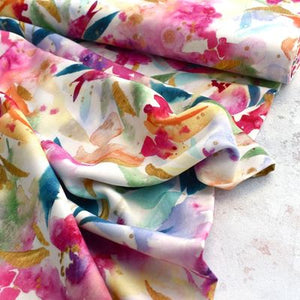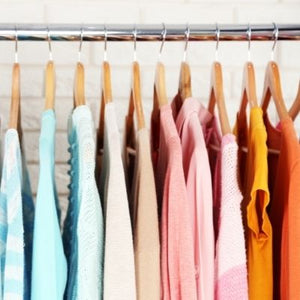While sewists likely don't have Trypanophobia, the extreme fear of needles, plenty of us get overwhelmed by the sheer number of sewing machine needles available from time to time. Combine the huge variety of sizes, styles, and types with the warnings that reaching for the wrong choice can potentially wreak havoc on our precious fabric; who wouldn't be scared?!
Let us help to ease that stress for you with a comprehensive guide to sewing machine needles. Learn the ins and outs of the different types of sewing machine needles and when to use them, what those tiny numbers mean, and why choosing the correct needle is important. Don’t worry—we promise there won’t be a pop quiz at the end!
Anatomy Lesson
Sewing machine needles are composed of eight main parts: the butt, shank, shoulder, blade, groove (on the front), scarf (on the back), eye, and point. Each of these plays a vital role in how the needle works in your machine and with the thread and fabric you are using.
 |
|
What’s Your Type?
When choosing the type of needle you are going to use for your project, the most important factors to consider are the type of fabric you’ll be using as well as the type and weight of the thread that will stitch it together. It is important that you select the correct needle to avoid either damaging your fabric or fraying your thread while constructing your garment. Here are the most commonly-used needles, along with when you should use them!
-
Universal—As its name suggests, this needle is the most common and can be used with both knit and woven fabrics and for a large variety of different projects.
-
Jersey—This needle is made specifically for knit fabrics and has a ball-point or rounded tip to ensure that there isn’t any damage caused to the fabric while sewing.
-
Stretch—Another ball-point needle, stretch needles are made for sewing with synthetic stretch fabrics, like swimwear, and are purposefully constructed to avoid skipped stitches.
-
Microtex/Sharp—These needles are specifically made with an extra-sharp point to precisely sew through delicate fabrics.
-
Denim/Jeans—This heavier weight needle is for especially dense or thick woven fabrics such as denim or imitation leather.
-
Topstitching—Made with an extra-large eye to accommodate thicker threads, this needle also features a sharp point for sewing straight, even stitches.
-
Twin Needle—This needle is two needles mounted on one shank and is used to create a double row of stitches in one pass. It is typically used for hemming knits with a standard sewing machine.

Size Matters!
Now that we have covered the type of needles used for various fabrics, there is still the decision of which size needle you’ll need. While intimidating at first, once you understand the basic sizes and the fabrics they best suit, it gets easier!
Similar to the Metric and Imperial systems of measurement, there are two different types of sewing machine needle sizes (European and American), as shown on the chart below. Luckily, most brands label their needles with both!
The basic rule of thumb for the needle size is that the thicker the fabric, the higher the number. Here are some general guidelines:
| Needle Size | Fabric Weight | Sample Fabric Types |
| 60/8 or 65/9 | Very Fine or Delicate | Silk, Sheer, Taffeta, Microfiber |
| 70/10 or 75/11 | Light Weight | Rayon, Voile, Batiste, Gauze |
| 80/12 or 90/14 | Medium Weight | Knits, Shirtings, Linen |
| 100/16 or 110/18 | Heavy Weight | Denim, Corduroy, Twill, Canvas |
| 120/19 | Extra Heavy Weight | Upholstery, Thick Leather |
Each sewing machine needle brand has a different way of marking these numbers and/or the type on the needle itself. For example, there are two color bands on the shoulder of Schmetz needles (our favorite brand!) to help identify each needle. The top band represents the needle type (Universal, Topstitch, Jersey, etc.), and the lower band represents the size of the needle (75/11, 100/16, etc.). Check what system your preferred needle brand uses and see if they have a chart you can keep in your sewing space for easy reference. Find Schmetz's chart HERE.
Sew Smart! Make sure you always have extra needles in your stash! In a pinch, you can get away with only using Universal 80/12 and 90/14, for the most part. Other helpful additions to your stash are Jersey 80/12 and Microtex 70/10, which will cover most knits and more delicate wovens. And, if you’re a sewist who works with a lot of bottom weights or does a lot of bag-making, a Denim 100/16 is also good to have on-hand!

UH OH!
Whenever there’s an issue with our laptops or cell phones, the first thing that the Help Desk tells us to do is to reboot. It seems impossible that something so simple could fix the issue, but nine times out of ten, that’s exactly what happens! While restarting your sewing machine likely won't help sewing issues, rethreading your machine and checking your needle just might!
Here are a few common issues that come up that may be resolved by checking or changing your needle:
- Broken upper or bobbin thread
- Puckering Fabric
- Irregular or fraying stitches
- Skipped stitches
- Sewing machine sounds a bit noisier than usual

Trash or Treasure?
Your sewing machine needles won’t last forever, and keeping them around past their prime will only lead to heartache, or at least skipped stitches and sub-par seams. Since needles aren’t a huge expense in your sewing budget, you are much better off trying to conserve elsewhere rather than pushing your luck with old needles.
But how often should you change your sewing machine needle? There are various suggestions based on the number of hours, projects, or bobbins used, but we recommend using whichever estimate you will most likely remember! Options include every 8-10 hours of sewing or every 3-4 full bobbins. Rather go by the number of projects? Consider the type of fabric you are working with; if you are constructing garments out of a lightweight fabric (ex. rayon challis or cotton lawn), you can typically go two or three projects before having to change your needle. If you're making a pair of jeans or using a heavyweight fabric, you are definitely better off changing that needle after each project.
Sew Smart! Safety first when disposing of old and broken needles! Some storage/container ideas we’ve used include mint tins, sharps bins, mason or spice jars, and old prescription containers.
Regardless of which method you choose, be sure to clearly label the container and make sure it is well-sealed before it is thrown out or recycled. Check with local authorities if there are specific disposal requirements in your area.

Needle Storage and Organization
Where and how you organize your needles, among your other sewing notions, is all personal preference. Here are some helpful suggestions that we have heard about or tried over the years.
- For packs of needles:
- Needle Store—Our favorite new needle organizer for both packages and loose needles, available in our shop.
- DIY Sewing Needle Organizers—made from fabric, there are a ton of tutorials on YouTube and sewer’s blogs
- Drawer organizer—like those used for cutlery
- Plastic binder inserts—like those used for business or baseball cards
- Daily vitamin/pill cases or other small plastic organizers
- Small mint tins—use a separate tin for each needle type and size, and partially used needles can be loose in the container
- Return them to the plastic case they came in and mark the case or the needles which ones are used
- For individual needles:
- Pincushions—label the different sections of a pincushion with type and/or size and put the needles in the corresponding areas
- Construct a paneled fabric board with different types of fabric swatches used to keep the needles for that kind of fabric
- Wonder Clips—insert the tip of the needle between the clamps and use a color that indicates what type of needle it is
Sewing machine needles may not be the most exciting of notions involved in our beloved craft, but they are a necessity worth understanding to make sure you’re choosing wisely to get the most out of each of your makes!
We SEW want to know what you think! Let us know any tips and tricks you’ve used over the years for keeping your needles in order. Please share what has worked for you in the comments and help someone find a sewlution of their own!







Great article, very detailed. I did notice that the diagram of the needle and the list to its right do not match. There are terms in the list (blade) that aren’t in the diagram, and the definition of Shoulder names should in the definition.
Leave a comment